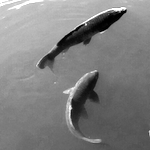A 3D hydrodynamic toy model for fish locomotion
1 : Laboratoire Interdisciplinaire de Physique [Saint Martin d'Hères]
Centre National de la Recherche Scientifique, Université Grenoble Alpes, Centre National de la Recherche Scientifique : UMR5588
2 : ModELisation de l'apparence des phénomènes Non-linéaires
Inria Grenoble - Rhône-Alpes, Laboratoire Jean Kuntzmann
3 : OPTique et IMAgeries [Grenoble]
Laboratoire Interdisciplinaire de Physique [Saint Martin d’Hères]
Collective motion of animals are ubiquitous and it occurs at different scales and in different dimensions [1,2]. Historically, the study of these phenomena begins with the Vicsek model, which features only short-range interaction between agents. For evolved animals, these interactions are cognitive and environmental, it takes a more complex form [3]. Moreover, the locomotion of the agent can affect the interaction [4].
The social interaction of fish has been mainly studied in 2D without hydrodynamic interactions [2,5,6] or with hydrodynamic interactions in the limit of the far-field hydrodynamic limit [7,8]. The locomotion of fish changes the flow around its body in a complex manner, it leads to hydrodynamic interaction which plays a role at all range. Thus, it could compete with cognitive interaction. Some efforts have been done to describe precisely the flow generated around a fish [9]. However, it is costly and can not be used to study the properties of a large school of fish.
In this work, we propose a 3D toy model of fish that is able to generate the vortex wake induced by the fish locomotion and which is light compare to solving the fish tail flapping. In this model, we describe the fish by a penalty method and achieve the description of the tail flapping by using a virtual tail exerting a torque in the fluid. The trajectory of the fish is determined by the relative position of the virtual tail. We perform a full characterization of the toy model, and compare it to the scaling found in the animal kingdom [10].
[1] A. Cavagna, et al., PNAS 107, 11865–11870 (2010).
[2] J. Gautrais, et al., J. Math. Biol. 58, 429–445 (2009).
[3] N. W. F. Bode, et al., Animal Behaviour 82, pp. 29-38 (2011)
[4] I. Ashraf, et al., PNAS 114, 9599-9604 (2017).
[5] J. Gautrais, et al., PLoS Comput. Biol. 8, e1002678 (2012).
[6] D. S. Calovi, et al., NJP, 16(1), 015026 (2014).
[7] A. C. H. Tsang, et al., J. Nonlinear Sci., 23, 971-991 (2013).
[8] A. Filella, et al., Phys. Rev. lett., 120(19), 198101 (2018).
[9] M. Bergmann, et al., Bioinspiration & biomimetics, 9(4), 046001 (2014).
[10] M. Gazzola, et al., Nat. Phys., 10(10), 758-761(2014).

 PDF version
PDF version
